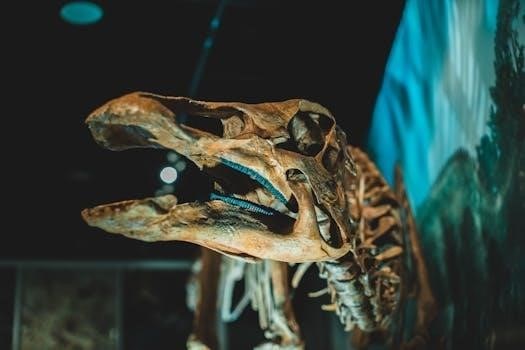Evolution Webquest⁚ Answer Key PDF
An Evolution Webquest Answer Key PDF is a valuable tool. It helps students and educators. This resource provides solutions to webquest activities. It ensures a deeper understanding of evolutionary concepts. It also offers accurate answers for comprehensive learning and efficient assessment.
Evolution webquests provide an engaging and interactive method for students to explore the complexities of evolutionary biology. These online activities guide learners through various websites and resources. They answer questions and complete tasks related to key evolutionary concepts. Evolution webquests often cover topics such as natural selection, genetic variation, fossil evidence, and comparative anatomy. They are designed to promote critical thinking and problem-solving skills.
The use of technology in education, particularly through webquests, allows for a dynamic and self-paced learning experience. Students can explore evolutionary principles in a structured yet flexible manner. Webquests enhance comprehension and retention. They incorporate multimedia elements and real-world examples. Many webquests also include answer keys. These answer keys serve as valuable tools for both students and educators. They allow for self-assessment and immediate feedback.
Answer keys ensure that students grasp fundamental concepts. They also assist teachers in evaluating student progress effectively. Evolution webquests are a great way to introduce evolutionary concepts. They are also a great way to reinforce learning in a way that is engaging and accessible.
Key Concepts Covered in Evolution Webquests
Evolution webquests delve into a multitude of essential biological concepts. These concepts form the bedrock of evolutionary theory. One core topic is natural selection. Natural selection elucidates how organisms with advantageous traits are more likely to survive and reproduce. This leads to the prevalence of these traits in subsequent generations. Adaptation is another key concept. It explains how organisms evolve to better suit their environments. Genetic variation plays a pivotal role. It highlights how differences in genes within a population drive evolutionary change.
The study of fossil evidence is crucial. It provides tangible proof of past life forms. It also demonstrates transitional forms that bridge evolutionary gaps. Comparative anatomy showcases similarities and differences in the anatomical structures of different species. This often points to common ancestry. Molecular biology examines genetic code. It reveals the relatedness of organisms at the molecular level.
Webquests often incorporate interactive elements. They include simulations and case studies. These elements help students grasp these complex ideas. Understanding these key concepts is vital for comprehending the mechanisms and evidence supporting evolution. These webquests are really helpful for students to learn the basics of evolution.

Natural Selection and Adaptation
Natural selection is a cornerstone of evolutionary theory. It describes how certain traits become more or less common. This happens based on an organism’s interaction with its environment. Individuals with advantageous traits are better equipped to survive. They reproduce at higher rates. This leads to these traits becoming more prevalent in future generations. This process is often summarized as “survival of the fittest.” However, fitness refers to reproductive success. It is not necessarily physical strength.
Adaptation is the result of natural selection. It refers to the evolutionary changes that make organisms better suited to their specific environments. Adaptations can be structural. For example, the long neck of a giraffe. They can also be behavioral. For example, migration patterns of birds. Or they can be physiological. For example, the ability of certain bacteria to resist antibiotics.
Webquests often explore examples of natural selection and adaptation. They often use case studies. Examples include Darwin’s finches. They demonstrate how different beak shapes evolved. This evolution allowed the finches to exploit different food sources on the Galapagos Islands. Understanding natural selection and adaptation is crucial. It is vital for grasping how evolution drives the diversity of life on Earth.
Genetic Variation⁚ The Key to Evolution
Genetic variation is the raw material that fuels evolution. Without it, natural selection would have nothing to act upon. This variation arises primarily through mutations. Mutations are random changes in the DNA sequence. These changes can be beneficial, neutral, or harmful. Beneficial mutations can lead to new traits. These traits enhance an organism’s survival and reproduction.
Another important source of genetic variation is sexual reproduction. During sexual reproduction, genes from two parents combine. This creates offspring with unique combinations of traits. This process, called recombination, shuffles genes. It increases the diversity within a population.
Gene flow, the movement of genes between populations, also contributes to genetic variation. When individuals migrate and interbreed, they introduce new alleles. Alleles are different versions of a gene. This can increase the genetic diversity of the recipient population.
Webquests often delve into the mechanisms of genetic variation. They explore how mutations, sexual reproduction, and gene flow interact. This interaction shapes the genetic makeup of populations. Understanding genetic variation is crucial. It explains how populations adapt to changing environments. It also explains how new species arise over time.
Evidence for Evolution⁚ Webquest Exploration
Webquests are excellent tools to explore evidence for evolution. These interactive activities guide students through various lines of evidence. These lines of evidence support the theory of evolution. They often include links to websites, videos, and interactive simulations. This allows for a comprehensive learning experience.
Fossil evidence is a cornerstone. Fossils show the progression of life over millions of years. They reveal transitional forms that bridge gaps between different groups of organisms. Comparative anatomy provides another line of evidence. Homologous structures, like the bones in a human arm and a whale’s flipper, suggest common ancestry.
Molecular biology offers compelling evidence. The universality of the genetic code and similarities in DNA sequences indicate a shared evolutionary history. Biogeography, the study of the distribution of species, also supports evolution. The presence of unique species on islands, like Darwin’s finches, is a testament to adaptation and diversification.
Webquests often challenge students. They analyze data, interpret diagrams, and draw conclusions based on the evidence. They promote critical thinking and a deeper understanding of the evolutionary process. Answer keys are essential for assessing student comprehension and providing feedback.
Fossil Evidence and Transitional Forms
Fossil evidence is a crucial component in understanding evolution. Fossils provide a tangible record of past life. They demonstrate how organisms have changed over geological time. By examining fossils, scientists can reconstruct evolutionary lineages. They also gain insights into the relationships between extinct and extant species.
Transitional forms are particularly significant. These fossils exhibit characteristics of both ancestral and descendant groups. They bridge the morphological gap between different types of organisms. A classic example is Archaeopteryx. It displays features of both reptiles and birds, supporting the evolutionary link between them.
Fossil discoveries continually refine our understanding of evolutionary history. Each new find provides additional data points. It also helps to clarify the relationships between species. Fossil evidence is not always complete. The fossil record is inherently biased towards organisms with hard parts. It also favors environments conducive to fossilization.
Nevertheless, the wealth of fossil evidence supports the theory of evolution. It demonstrates the gradual changes that have occurred in life forms over millions of years. Answer keys for webquests focusing on fossil evidence and transitional forms assist students. They also ensure they accurately interpret the data.

Comparative Anatomy and Homologous Structures

Comparative anatomy is a cornerstone of evolutionary biology. It involves studying the similarities and differences in the anatomical structures of different organisms. By comparing these structures, scientists can infer evolutionary relationships and trace common ancestry. Homologous structures are a key concept in this field.
Homologous structures are anatomical features that share a common evolutionary origin. They may have different functions in different species; For example, the forelimbs of humans, bats, and whales are homologous. They have different functions but share a similar underlying bone structure. This similarity indicates a shared ancestor from which these structures were modified over time.
The study of homologous structures provides strong evidence for evolution. It demonstrates how natural selection can modify existing structures for different purposes. This process is known as adaptive radiation. Understanding comparative anatomy and homologous structures is essential for comprehending evolutionary relationships.
Answer keys for webquests on this topic help students grasp these complex concepts. They also guide them in identifying homologous structures and interpreting their evolutionary significance. These resources provide accurate answers and explanations. They ensure students understand the evidence supporting common descent and adaptive evolution.
Molecular Biology and Genetic Code
Molecular biology offers compelling evidence for evolution. It delves into the genetic code, DNA, RNA, and proteins. These molecules reveal evolutionary relationships. The universality of the genetic code across all life forms suggests a common ancestor. Similarities in DNA sequences indicate closer evolutionary ties.
The study of molecular biology provides insights into how genetic changes drive evolution. Mutations, gene flow, and genetic drift alter the genetic makeup of populations. This leads to the emergence of new traits and species over time. Comparing the genomes of different species helps scientists construct evolutionary trees. These trees illustrate the relationships between organisms.
Answer keys for webquests on molecular biology clarify complex concepts. They guide students through analyzing DNA sequences. They help in understanding protein structures. They also explain how these molecular features support evolutionary theory. These resources provide accurate answers and explanations. This ensures a solid grasp of genetic code, mutations, and molecular evidence.
Students also learn how molecular data complements anatomical and fossil evidence. This provides a comprehensive understanding of evolution. Molecular biology and genetic code are essential for comprehending the mechanisms and evidence of evolution.
Webquest Activities and Answer Types
Evolution webquests offer various activities to engage students. These activities enhance their understanding of evolutionary concepts. Common webquest activities include fill-in-the-blanks, short answer questions, and multiple-choice quizzes. Some webquests incorporate interactive simulations and data analysis tasks. These diverse activities cater to different learning styles.
Answer types in evolution webquests vary based on the activity. Fill-in-the-blanks require students to recall specific terms or facts. Short answer questions prompt students to explain concepts in their own words. Multiple-choice quizzes test comprehension and critical thinking. Simulations allow students to manipulate variables. They observe the effects on evolutionary processes.
Answer keys provide correct responses for each activity type. They help students assess their understanding. They also guide them in correcting misunderstandings. Effective answer keys include explanations for each answer. This supports deeper learning. They offer insights into the reasoning behind the correct choice.
Webquests also encourage students to explore websites. They analyze data and draw conclusions. This fosters critical thinking skills. The answer keys guide students in interpreting data. They help in forming well-supported arguments. By engaging with diverse activities and answer types, students gain a comprehensive grasp of evolution.
Using Answer Keys Effectively
Answer keys are essential tools for evolution webquests. They guide students in understanding complex concepts. The effective use of answer keys enhances learning outcomes. Students should first attempt the webquest activities independently. This allows them to engage with the material. It promotes critical thinking before consulting the answer key.
Upon completion, students should use the answer key to check their responses. They should focus on understanding the reasoning behind each answer. Simply memorizing answers does not foster true comprehension. Instead, students should analyze their mistakes. They should identify areas where their understanding is lacking.
Teachers can use answer keys to assess student progress. They can identify common misconceptions. This informs future instruction and targeted support. Answer keys also save time. They streamline the grading process.
Encourage students to explain why an answer is correct. This reinforces their understanding. It promotes deeper learning. Emphasize that answer keys are learning tools. They are not simply shortcuts to completing assignments. Used effectively, answer keys support meaningful learning. They promote a deeper understanding of evolution. This improves overall academic performance.
Resources for Evolution Webquests and Answer Keys

Finding reliable resources for evolution webquests and answer keys is crucial for effective learning and teaching. Many educational websites offer comprehensive webquests covering various aspects of evolution. These resources often include interactive activities, videos, and detailed explanations. Teachers can adapt these resources to suit their curriculum needs.
Several websites provide answer keys to accompany evolution webquests. These answer keys offer valuable guidance for students and educators. They ensure accuracy and promote deeper understanding. Look for resources that offer detailed explanations. These explanations should clarify the reasoning behind each answer. This fosters a more comprehensive learning experience.
Repositories of educational materials often host user-created webquests. These platforms can be a treasure trove of diverse and engaging activities. However, verify the accuracy and reliability of these resources before using them.
Textbooks and scientific publications serve as excellent sources of information for creating or supplementing webquests. They provide the scientific background needed for accurate content.
Consider using reputable educational publishers for high-quality webquests and answer keys. Ensure that the resources align with learning objectives. They should promote critical thinking and inquiry-based learning. Effective resources enhance the educational experience. They deepen student understanding of evolution.


